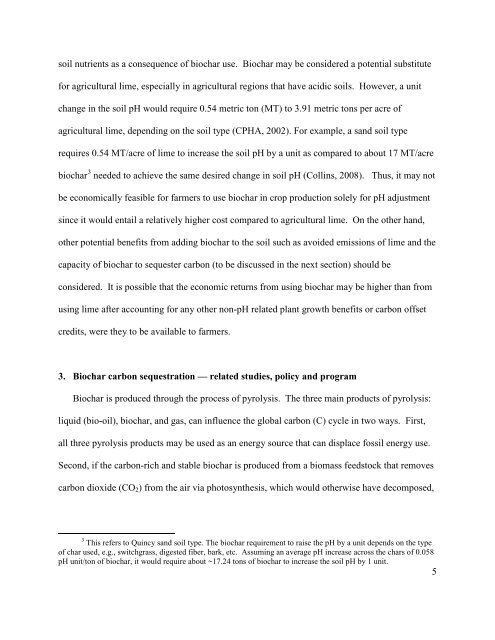The Economic Value of Biochar in Crop Production and Carbon ...
The Economic Value of Biochar in Crop Production and Carbon ...
The Economic Value of Biochar in Crop Production and Carbon ...
You also want an ePaper? Increase the reach of your titles
YUMPU automatically turns print PDFs into web optimized ePapers that Google loves.
soil nutrients as a consequence <strong>of</strong> biochar use. <strong>Biochar</strong> may be considered a potential substitutefor agricultural lime, especially <strong>in</strong> agricultural regions that have acidic soils. However, a unitchange <strong>in</strong> the soil pH would require 0.54 metric ton (MT) to 3.91 metric tons per acre <strong>of</strong>agricultural lime, depend<strong>in</strong>g on the soil type (CPHA, 2002). For example, a s<strong>and</strong> soil typerequires 0.54 MT/acre <strong>of</strong> lime to <strong>in</strong>crease the soil pH by a unit as compared to about 17 MT/acrebiochar 3 needed to achieve the same desired change <strong>in</strong> soil pH (Coll<strong>in</strong>s, 2008). Thus, it may notbe economically feasible for farmers to use biochar <strong>in</strong> crop production solely for pH adjustments<strong>in</strong>ce it would entail a relatively higher cost compared to agricultural lime. On the other h<strong>and</strong>,other potential benefits from add<strong>in</strong>g biochar to the soil such as avoided emissions <strong>of</strong> lime <strong>and</strong> thecapacity <strong>of</strong> biochar to sequester carbon (to be discussed <strong>in</strong> the next section) should beconsidered. It is possible that the economic returns from us<strong>in</strong>g biochar may be higher than fromus<strong>in</strong>g lime after account<strong>in</strong>g for any other non-pH related plant growth benefits or carbon <strong>of</strong>fsetcredits, were they to be available to farmers.3. <strong>Biochar</strong> carbon sequestration — related studies, policy <strong>and</strong> program<strong>Biochar</strong> is produced through the process <strong>of</strong> pyrolysis. <strong>The</strong> three ma<strong>in</strong> products <strong>of</strong> pyrolysis:liquid (bio-oil), biochar, <strong>and</strong> gas, can <strong>in</strong>fluence the global carbon (C) cycle <strong>in</strong> two ways. First,all three pyrolysis products may be used as an energy source that can displace fossil energy use.Second, if the carbon-rich <strong>and</strong> stable biochar is produced from a biomass feedstock that removescarbon dioxide (CO 2 ) from the air via photosynthesis, which would otherwise have decomposed,3 This refers to Qu<strong>in</strong>cy s<strong>and</strong> soil type. <strong>The</strong> biochar requirement to raise the pH by a unit depends on the type<strong>of</strong> char used, e.g., switchgrass, digested fiber, bark, etc. Assum<strong>in</strong>g an average pH <strong>in</strong>crease across the chars <strong>of</strong> 0.058pH unit/ton <strong>of</strong> biochar, it would require about ~17.24 tons <strong>of</strong> biochar to <strong>in</strong>crease the soil pH by 1 unit.5
















